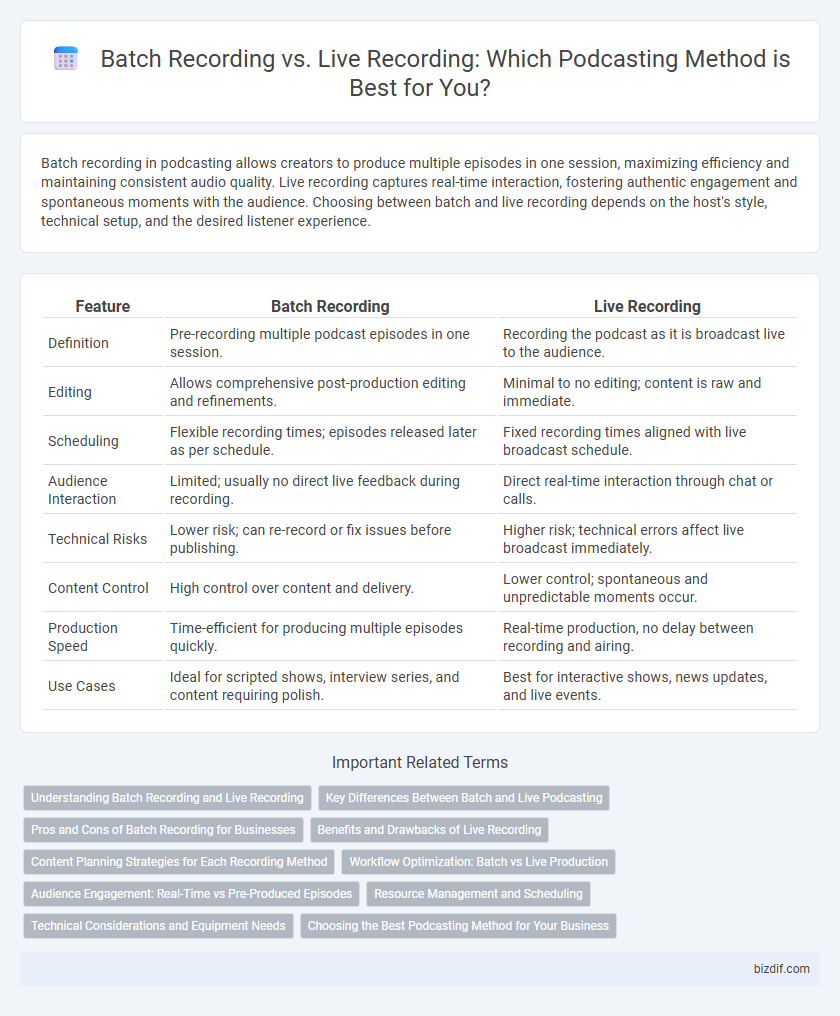Batch recording in podcasting allows creators to produce multiple episodes in one session, maximizing efficiency and maintaining consistent audio quality. Live recording captures real-time interaction, fostering authentic engagement and spontaneous moments with the audience. Choosing between batch and live recording depends on the host's style, technical setup, and the desired listener experience.
Table of Comparison
| Feature | Batch Recording | Live Recording |
|---|---|---|
| Definition | Pre-recording multiple podcast episodes in one session. | Recording the podcast as it is broadcast live to the audience. |
| Editing | Allows comprehensive post-production editing and refinements. | Minimal to no editing; content is raw and immediate. |
| Scheduling | Flexible recording times; episodes released later as per schedule. | Fixed recording times aligned with live broadcast schedule. |
| Audience Interaction | Limited; usually no direct live feedback during recording. | Direct real-time interaction through chat or calls. |
| Technical Risks | Lower risk; can re-record or fix issues before publishing. | Higher risk; technical errors affect live broadcast immediately. |
| Content Control | High control over content and delivery. | Lower control; spontaneous and unpredictable moments occur. |
| Production Speed | Time-efficient for producing multiple episodes quickly. | Real-time production, no delay between recording and airing. |
| Use Cases | Ideal for scripted shows, interview series, and content requiring polish. | Best for interactive shows, news updates, and live events. |
Understanding Batch Recording and Live Recording
Batch recording involves pre-producing multiple podcast episodes in one session, allowing for meticulous editing and consistent quality control before release. Live recording captures real-time conversations or performances, delivering immediacy and authentic audience interaction but with limited post-production flexibility. Understanding these methods helps podcasters balance efficiency, content control, and listener engagement based on their specific goals.
Key Differences Between Batch and Live Podcasting
Batch recording allows podcasters to pre-record multiple episodes in one session, ensuring consistent audio quality and easier editing workflows. Live recording captures real-time interactions, offering authentic listener engagement and immediate feedback, but requires flawless execution without post-production fixes. The key differences lie in production control, audience interaction, and the flexibility of editing options.
Pros and Cons of Batch Recording for Businesses
Batch recording in podcasting allows businesses to produce multiple episodes in one session, maximizing efficiency and ensuring consistent content flow. This method enables better control over audio quality and editing, reducing the risk of live mistakes while saving time on scheduling. However, batch recording can limit spontaneity and real-time interaction, potentially impacting listener engagement and the sense of immediacy that live recordings offer.
Benefits and Drawbacks of Live Recording
Live recording in podcasting offers real-time audience interaction and a spontaneous, authentic feel that can boost listener engagement and create a dynamic atmosphere. However, it carries risks such as technical difficulties, limited editing opportunities, and increased pressure on hosts to deliver flawless content without errors. Despite these drawbacks, live recording can enhance immediacy and foster a stronger connection with the audience through direct communication.
Content Planning Strategies for Each Recording Method
Batch recording enables podcasters to efficiently produce multiple episodes in one session by leveraging detailed content calendars and topic clustering to maintain consistency. Live recording demands real-time content structuring with flexible outlines and audience interaction plans to ensure dynamic engagement. Tailoring content planning strategies to each method enhances workflow optimization and listener experience.
Workflow Optimization: Batch vs Live Production
Batch recording streamlines podcast production by capturing multiple episodes in one session, significantly reducing setup time and editing complexity. Live recording demands real-time coordination and often limits post-production flexibility, increasing the chances of errors and technical issues. Optimizing workflow favors batch recording for consistent quality control and efficient content scheduling.
Audience Engagement: Real-Time vs Pre-Produced Episodes
Live recording fosters immediate audience engagement through interactive Q&A sessions and spontaneous reactions, enhancing listener connection and feedback. Batch recording offers polished, pre-produced episodes that emphasize content quality and consistency but lack real-time audience interaction. Podcasters must balance the dynamic engagement of live shows with the controlled, refined experience of batch-produced content to optimize listener involvement.
Resource Management and Scheduling
Batch recording in podcasting enables efficient resource management by consolidating multiple episodes into a single session, reducing setup time and studio costs. Live recording demands real-time coordination of hosts, guests, and technical staff, posing greater scheduling challenges and potential for unexpected delays. Opting for batch recording streamlines production workflows, allowing for flexible scheduling and optimized allocation of editing and distribution resources.
Technical Considerations and Equipment Needs
Batch recording in podcasting requires reliable multi-track recording software and quality microphones to ensure consistent audio levels and ease of post-production editing, while live recording demands robust streaming equipment, stable internet connection, and often a mixer for real-time audio adjustments. Technical considerations for batch recording emphasize controlled environments and noise isolation, whereas live recording prioritizes latency minimization and backup solutions to prevent data loss during broadcast. Understanding the equipment needs for each method enhances production quality and workflow efficiency in podcast creation.
Choosing the Best Podcasting Method for Your Business
Batch recording allows podcasters to produce multiple episodes in one session, optimizing time management and ensuring consistent audio quality, which suits businesses aiming for scalable content delivery. Live recording offers real-time audience interaction and spontaneity, enhancing engagement and fostering a loyal community, ideal for brands prioritizing authentic connections. Selecting the best podcasting method depends on business goals, resource availability, and audience preference, balancing efficiency with interactivity.
Batch Recording vs Live Recording Infographic

 bizdif.com
bizdif.com